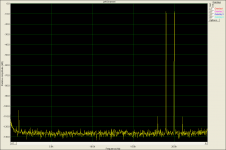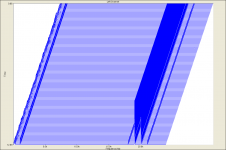AES members with high-end test equipment have reported that SACD media players are often limited to about 20 kHz output. That would put them on par with CD in terms of frequency response. Claims of higher sampling rates are just marketing, and are not always verifiable when it comes to actual recordings. SACD is roughly equivalent to 20-bit PCM at 96 kHz, but it's difficult to find examples that actually reach this promise.That's really grasping at straws. No, I've had no complaints with the CD layer of SACD in comparison other CDs. They often sound very good. Just not as good as SACD in the comparisons I've made. They often sound closer in quality than the separate releases of the same music.
It's here. Digital downloads. I recently purchased a lossless (FLAC) album that was 24-bit, and the web page didn't even bother to mention the 24-bit quality. I checked the samples, and it's not merely 16-bit samples in 24-bit words - the samples are actually using all 24 bits. These days, you can download an entire "CD" of music in under 3 minutes, even with lossless formats. It's a little more difficult to go beyond 16-bit, but the more we buy, the more that will be produced.No, I'm ready for a high resolution format, not that the industry cares.
The AD1853 has one thing going for it though, it is cheap.
ADI's website lists it as $7.59/1k. Cheap compared to ESS901X and PCM1704 I'll grant
Here is a link to the original paper:http://tf.boulder.nist.gov/general/pdf/1244.pdf It seems Mylar gave the best result?Thanks, I have free access when I get back. PM noise makes sense as now it hurts in RF circuits. If you extend the plots to the right to a virtual meeting point it will be at a frequency over which the noise per se can not be a problem. This looks to be less than 100kHz. But at RF there is mixing up.
EDIT - Got it over VPN, seems same issue though they use their own slightly esoteric way of describing the problem. I guess I was unlucky it looks like almost anything is better than SM.
Setting up to measure additive phase noise at -170 dB is not a simple task. And while there is some correspondence to thermal noise it may not hold to equate them. At least I now will know its OK to use Mylar or ceramic caps in the clock distribution system. And the modulation seen in the polystyrene would not be good in a clock distribution or elsewhere. I wonder how much audio myth is really just different forms of microphonics.
I just had an idea, when I get back on Wednesday I will try 50pf of PC board matierial known to have horrible DA.
At the other extreme you may be able to scrounge 50 pF worth of Teflon pcb. Or even a twisted pair of Teflon jacketed wires.
Thanks for the link to the IEEE paper, Demian.
Could someone kindly define the 'DA' acronym that has popped up in the last several pages of this thread? I must confess that I am suffering from acronym overload, because I've lost the reference here. It's certainly not "D/A" or 'DAC' - I believe someone mentioned Diode Amplification, but that's nothing I've seen defined in the industry. Thanks.
Could someone kindly define the 'DA' acronym that has popped up in the last several pages of this thread? I must confess that I am suffering from acronym overload, because I've lost the reference here. It's certainly not "D/A" or 'DAC' - I believe someone mentioned Diode Amplification, but that's nothing I've seen defined in the industry. Thanks.
AES members with high-end test equipment have reported that SACD media players are often limited to about 20 kHz output. That would put them on par with CD in terms of frequency response. Claims of higher sampling rates are just marketing, and are not always verifiable when it comes to actual recordings. SACD is roughly equivalent to 20-bit PCM at 96 kHz, but it's difficult to find examples that actually reach this promise.
http://en.wikipedia.org/wiki/Super_Audio_CD#Technical_background said:SACD audio is stored in a format called Direct Stream Digital (DSD), which differs from the conventional Pulse-code modulation (PCM) used by the compact disc or conventional computer audio systems.
DSD is 1-bit, has a sampling rate of 2.8224 MHz, and makes use of noise shaping quantization techniques in order to push 1-bit quantization noise up to inaudible ultrasonic frequencies. This gives the format a greater dynamic range and wider frequency response than the CD. The SACD format is capable of delivering a dynamic range of 120 dB from 20 Hz to 20 kHz and an extended frequency response up to 100 kHz, although most currently available players list an upper limit of 70–90 kHz,[35] and practical limits reduce this to 50 kHz.[2] Because of the nature of sigma-delta converters, one cannot make a direct technical comparison between DSD and PCM. DSD's frequency response can be as high as 100 kHz, but frequencies that high compete with high levels of ultrasonic quantization noise.[36] With appropriate low-pass filtering, a frequency response of 50 kHz can be achieved along with a dynamic range of 120 dB.[2] This is about the same resolution as PCM audio with a bit depth of 20 bits and a sampling frequency of 96 kHz.[2] Thus, DSD looks inferior to a "standard" PCM 24bit/96 kHz even using slightly more bandwidth than PCM (2.8224 Mbit/s vs 2.304 Mbit/s).
Looks that way. Maybe that's why I've been so impressed by music on Bluray.
It's here. Digital downloads. I recently purchased a lossless (FLAC) album that was 24-bit, and the web page didn't even bother to mention the 24-bit quality. I checked the samples, and it's not merely 16-bit samples in 24-bit words - the samples are actually using all 24 bits. These days, you can download an entire "CD" of music in under 3 minutes, even with lossless formats. It's a little more difficult to go beyond 16-bit, but the more we buy, the more that will be produced.
How big are the 24bit/96kHz flac files? HD Tracks doesn't seem to list file sizes that I can tell.
When I start thinking about storing all this music on a hard disc it kind of makes me ill. Just storing all our CDs uncompressed would be a nightmare.
But, yeah it looks like that's the way Hi-Res audio is going. Too bad. There are a whole lot of Bluray player out there.
John
What length of acquisition window? How many bins FFT?
65536 samples per record, 96kHz sampling. 0.68s, 1.46Hz bin width. 100x averaged.
How big are the 24bit/96kHz flac files? HD Tracks doesn't seem to list file sizes that I can tell.
When I start thinking about storing all this music on a hard disc it kind of makes me ill. Just storing all our CDs uncompressed would be a nightmare.
But, yeah it looks like that's the way Hi-Res audio is going. Too bad. There are a whole lot of Bluray player out there.
John
There is a rapidly growing body of info on computer audio. I would start either here at DIYaudio or Computer Audiophile Computer Audiophile | High-End Audiophile Music Servers
Looking at my collection the worst case would be a 176.4/24 Reference Recordings wave format album at around 4.5 GB. If stored in FLAC its about 1/2 of that. A 96K FLAC would be roughly 1/2 of the 176.4 album. And for less than $100 you can now get a 2 TB drive that will store approx 400 of those hi res albums, more than have been created thus far. And a whole lot of good listening.
You can find lots on ripping the CD's at the link, and ripping services if you value your time above zero.
We should get back to the antique art of analog reproduction in honor of John's interests and contributions.
65536 samples per record, 96kHz sampling. 0.68s, 1.46Hz bin width. 100x averaged.
Thanks, that's almost 7 million samples shoehorned into a single jpg
Any variation in the (averaged) noise floor during the course of the test won't show up. Which I believe was Thorsten's point too. Our ears can detect noise variations over considerably shorter timescales than 68s.
With 1x averaging the result is not very different. Do you want for me to re-setup and repeat the test? 
Difficult for me to take Thorsten serious. TDA1541, which he prefers, has the most of artifacts and aliases in the audio band of all D/A converters I had on my test bench.
Difficult for me to take Thorsten serious. TDA1541, which he prefers, has the most of artifacts and aliases in the audio band of all D/A converters I had on my test bench.
Last edited:
With 1x averaging the result is not very different. Do you want for me to re-setup and repeat the test?
No because 1X averaging only gives us a 0.68s window. Again its too long to see noise modulation effects. Thanks for the offer though
Difficult for me to take Thorsten serious. TDA1541, which he prefers, has the most of artifacts and aliases in the audio band of all D/A converters I had on my test bench.
Yeah but you see what you want to see. Change your measurements to register things which people actually notice aurally (like noise modulation) and you'll begin to see the 1541 in a new light in comparison to your favoured low-bit devices.
They are not low bit devices. Sure, the modulator may be a 1 or a zero (hence the 'one bit" converter), but the data width depends on the sampling frequency and the decimation filter. 24bit converters for instrumentation using this technology have been around for years (I even built a few 20 bit in the late 80's with 1ppm resolution as part of an investigation at the company I worked for). I am with PMA on this one - but I doubt I will be able to convince the naysayers here.
They are not low bit devices.
What would you call those kinds of DACs then where the hardware DAC part is considerably narrower than the width of the input words? Low-bit works for me.
Sure, the modulator may be a 1 or a zero (hence the 'one bit" converter), but the data width depends on the sampling frequency and the decimation filter.
That's the width of the data going in. I wasn't referring to that in my characterization since the 1541 also has more than 1 bit going in.
24bit converters for instrumentation using this technology have been around for years (I even built a few 20 bit in the late 80's with 1ppm resolution as part of an investigation at the company I worked for).
Yes I agree, I seem to recall one from the then named 'Crystal Semiconductor' designed for the seismic market with a bandwidth of around 500Hz.
I am with PMA on this one - but I doubt I will be able to convince the naysayers here.
'With PMA' here means you also prefer the sound of noise-shaped converters? Or it means you prefer to evaluate DACs primarily by THD and static SNR?
same measurement with 1x averaging. Any problem seen?
I refer you again to post #16713.
- Status
- Not open for further replies.
- Home
- Member Areas
- The Lounge
- John Curl's Blowtorch preamplifier part II

